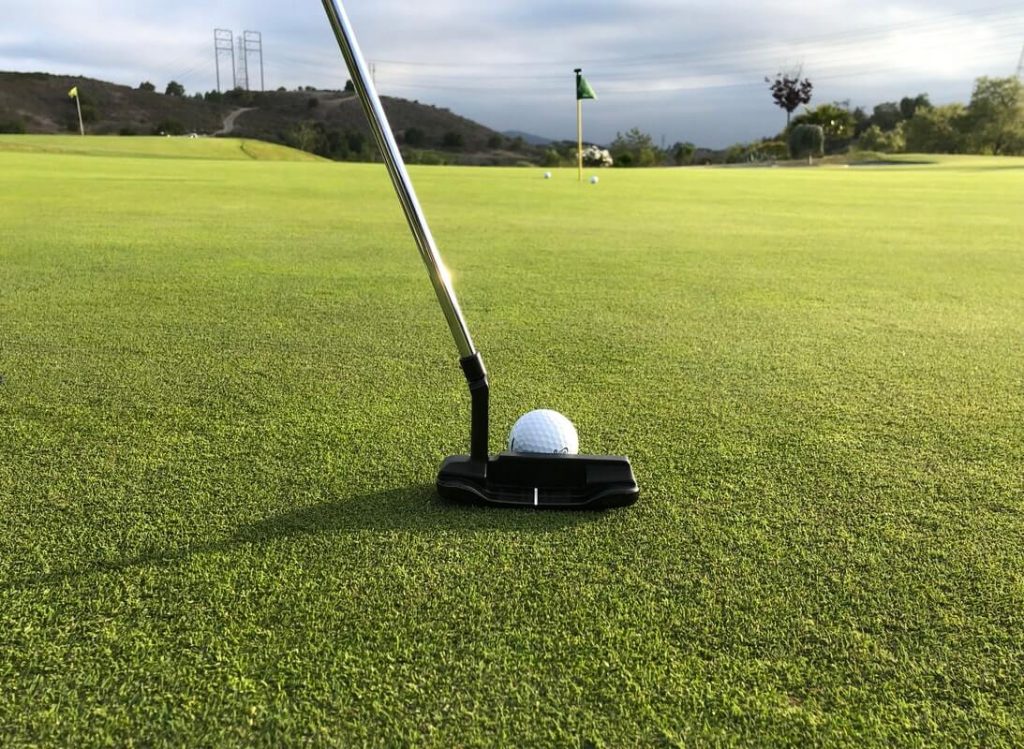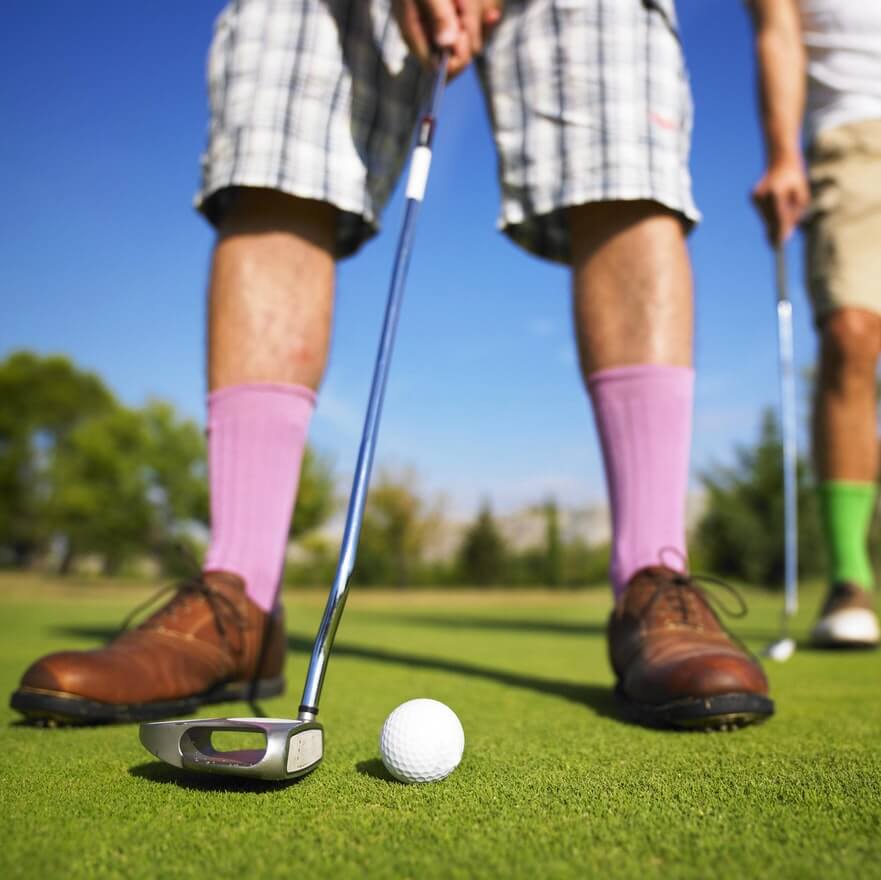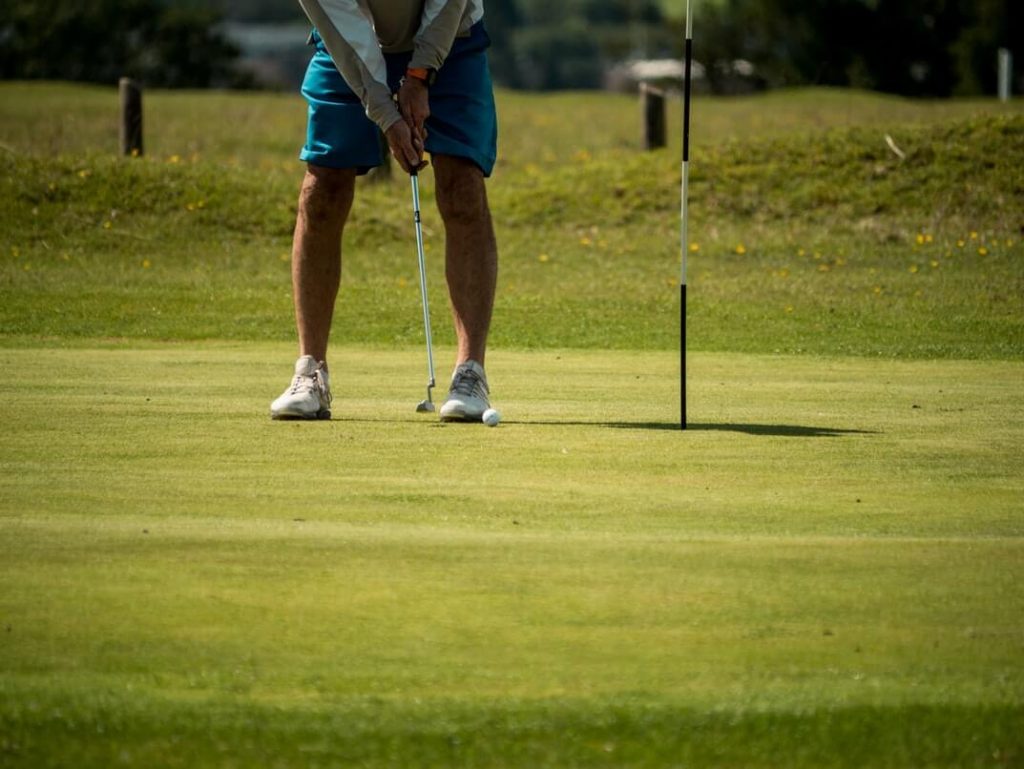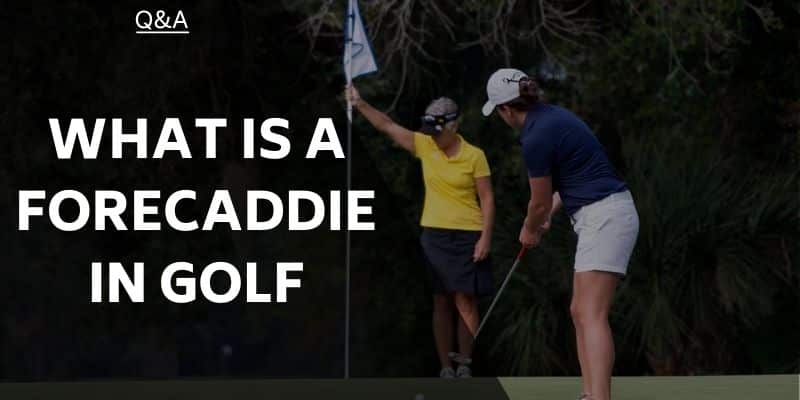If the weak part of your game is putting, golf becomes a frustrating endeavor. But one of the most straightforward ways to shave a few strokes off your game is to work on your putting.
Every golfer must know how to putt. You might not sink them all, but you should feel confident on the green.
Bobby Locke is considered by many as the greatest putter of all time. He also coined the phrase, “You drive for show, but putt for dough.”
There is no guarantee that you will be in his league after this article, but we will provide some guidance on how to putt to the best of your ability.
Best Way To Putt In Golf

Putting is an art that requires you to feel comfortable standing over the ball and pulling the trigger. Like anything, there are multiple ways to achieve success. It only requires loads of practice and time spent understanding grass and gradients.
Becoming great at putting will not happen overnight. You will have to work hard at it. Fortunately, we have a detailed guide to help you learn how to putt properly.
Feel Versus Technique
To master your putting technique, you need to combine the technical aspects and develop a feel for the green and your putter.
You only have 40 seconds to hit your putt when it is your turn, so you must have a good idea of what you expect the ball to do.
Golfers like Bryson DeChambeau have developed a system that provides technical insight on how far to take the putter back for specific distances. When you can achieve that, it will help you improve your distance control.
Putting on undulating greens adds to the challenge because of the slopes and grain direction. That is why it is imperative to have a good feel of how the ball will react to every change.
Speed Versus Line
Another combination that needs gel in golf putting is speed and line.
There are three lines to get your ball into the hole. The speed of the ball determines them all.
- The line that has the putt dying into the front edge (aka dead weight putting)
- The line that has it falling in at the side door
- The line that sees the ball hit the back of the hole
Once you have visualized where you want the ball to enter the hole, you can work out your line and start to factor in the severity of slope and grain.
You need to understand the percentage of slope, grain, and speed. The speed of your ball will impact whether it catches the break or not.
Controlling the speed of the ball is best achieved by regulating the length of your backswing and through-swing.
Short putts require a short swing back and through, and as the distance increases, the length of the stroke must increase.
Read The Green
The best time to start reading the green is on your approach.
Seeing the undulations from a distance offers you a different perspective than what you will get from close up.
You can then form a complete picture of the green and whether you can expect a slippery downhill putt or a slow uphill swinger.
Should you have an uphill putt, congratulations. You can be more aggressive on the stroke. If your putt is downhill, you need to be thinking about hitting it a bit softer.
Unless your approach shot ended up in tap-in territory, mark your ball, and stand back to view the green from close-up.
The close-up perspective could change your mind about the line that you considered in your approach.
It is advisable to pace the distance from your ball to the cup giving yourself an idea of how hard you will have to stroke the putt.
While pacing the distance, you will get a feel of the line and see deviations that you may have missed from a distance.
Alignment
The concept of alignment within putting features three parts. Alignment of the golf ball, your body, and the clubface.
Golfers frequently mark their balls with a marker to aid in the alignment of their golf balls for putting.
Some golf ball manufacturers add an alignment marker into the design of the golf ball.
Callaway’s Triple Track technology is the latest fad to hit the market in alignment aids. For this to be function, you have to play with a Callaway Triple Track putter. Along with a Triple Track Callaway golf ball that contains the markings.
You may have seen that professional golfers only remove the ball marker once they are 100 percent sure that the ball and the mark are aligned perfectly.
With the ball perfectly aligned with the mark, it is time to align your putter with the chosen line.
Most putters have an alignment system to ensure that you can line up your putt.
The last element to consider is lining your feet, hips, and shoulders parallel to your target line.
Now you are ready to putt. Once you are confident about how to putt straight along your line, you see improved accuracy on the greens.
Read also: Golf Alignment Stick Drills
Putter
If you are to learn how to putt in golf, you need to operate with the correct tools. Although all putters feature minimal to no-loft and are built for use on the green. They are purposed to serve the needs of different stroke types.
Mallet head putters deliver maximum forgiveness on off-center strikes. And they produce consistent topspin to ensure that your ball reaches the cup. They are advantageous for higher handicappers and inconsistent ball strikers.
Blade putters offer minimal forgiveness but deliver an exceptional feel for the traditionalists in our game.
Besides the head construction, you need to factor in the hosel design. Those with arc-strokes may find success with a plumber’s neck putter. However, if you possess a straight putting stroke, a center-shafted hosel is the way to go.
Let’s get back to the putting guide. But, if you are interested in learning more about flat sticks.
Read about: Best Putters Of All Time
The Grip
Grip pressure plays a significant role in the control and direction of the putt.
The way you grip the putter directly influences the angle of the putter face at impact. Gripping the putter too tightly will create tension in your stroke that will make it near impossible to hole the putt.
Putting grips are available in various shapes and sizes that range from standard grips and square putting grips to large and Jumbo grips.
Larger and Jumbo grips will assist you in holding the club and placing the correct pressure spread over a larger area. Furthermore, it will reduce the amount of hand movement and wrist bending.
The way you place your hands around the grip is called your grip. Gripping your putter is a personal preference. There is no right or wrong.
Your putter grip must feel comfortable in your hands without losing control over the head.
Let us look at the most used grips. There may be variations of the grips as golfers try and become more comfortable in the way they hold the putter grip.
Conventional Reverse Overlap Putting Grip
This grip is similar to a standard overlap grip used on full shots to maintain a consistent feel from full shots through putts.
It is the preferred grip for golf instructors and is used by up to 68.5 percent of professional golfers as it provides the golfer the best feedback during the stroke.
A critical factor in this grip is to get your leading thumb to rest on the flat section of the putter grip. This additional support will assist you in keeping the putter face square at impact.
The name stems from the leading index finger resting on top of the trailing little finger. This differs from the overlap grip where the trailing little finger rests on top of the leading index finger.
Variations of the grip come about by changing the leading index finger position on the trailing hand. You can point your leading index towards the ground or place it parallel to the trailing pinkie finger.
Cross-Handed Putting Grip
The Cross-Handed putting grip (aka, left-hand low grip) is the opposite of the conventional reverse overlap putting grip. Your leading hand is now lower on the grip than your trailing hand.
This is an excellent grip for golfers who fight an overactive trailing hand pushing the putter during the stroke. It will assist in aligning your putter face and keep the face square.
Your leading arm and wrist are aligned and less likely to create any break in your leading wrist.
Ideally, you want to rest both thumbs on the flat part of the putter grip for increased stability.
There are two ways to connect your hands in this grip.
- The leading little pinkie finger can rest below or on top of the right index finger.
Or:
- The trailing index finger can also point straight down and rest perpendicular to the fingers of the leading hand.
Cross-handed putting will take a while to get accustomed to and could impact your feel and pace.
The Claw Putting Grip
The claw putting grip has gained popularity since the early 2000s and is becoming more frequently used by golfers at all levels.
A reason for using the claw grip is that it removes the dominance of the trailing hand from your grip.
Your first step would be to grip the putter with your leading hand resting your thumb on the flat part of the putter grip.
You grip the putter with your right hand, placing it between 2 and 4 inches away from your leading hand.
Golfers using the claw grip vary in how they place and grip the putter with the trailing hand.
Importantly, as with all putter grips, the putter and stroke must feel comfortable in your hands.
Arm-Lock Putting Grip
When the rules changed and outlawed locking your putter grip against your chest, golfers found another way of locking in the putter shaft without contravening the rules.
Rule 14-1b does not consider to constitute anchoring your putter.
This grip sees the handle of the putter locks against the inside of your leading forearm.
This connection should stay intact throughout the stroke. This method always keeps the hands ahead of the ball through impact.
You may use any putting grip with the arm lock method, provided you maintain the forward angle of the putter through the stroke. Because of the forward-leaning shaft, you may find it challenging to line up the face of the putter.
To use this grip effectively, you require a putter with a minimum of 6 degrees of loft. And a shaft that is long enough to lock in against your forearm.
Read also: TOP Armlock Putters
Prayer Putting Grip
The prayer putting grip (aka palms-facing grip) have your palms facing each other and the thumbs next to each other.
At the back end of the grip, you can have the fingers of either hand on top. Decide which is the most comfortable in your hands.
This grip creates a perfect triangle as your hands are on the same level, and your shoulder is level as well. Now you can execute a perfect pendulum action with all parts coordinated.
Fingers Down The Shaft
This is a less frequently used grip and one that I have used with much success over a few decades.
The main feature of this grip is that it prevents wrist breakdown, provides an excellent feel, and gets the ball to the hole.
Leaving the putt short after a great approach shot is one of the most frustrating shots out on the course.
To avoid this, extend both index fingers down the side of the grip to even out the control.
If you only extend the trailing index finger, you could easily flip the putter at impact, thus catching the ball on the upswing.
Posture
Ok, your golf ball, putter, and body are all aligned. But what about my putting posture? How do I position myself, and where should your arms hang?
Most great putters allow their arms to hang directly under the shoulders to create a straight arc back and through.
Stand slightly upright with some bend in your knees to relieve tension.
Tilt forward from the hips, keeping your back straight, enabling your spine to rotate freely.
Putting The Ball

Before stroking the putt, I take a few practice strokes while facing the hole. That enables me to acquire a feel for the distance and the path of the face.
At this stage, I can visualize the ball traveling on the line at the speed that I stroke the ball.
Start The Ball On The Chosen Line
Whatever your putting path is, you must connect the ball in the center to start it off on the chosen line. Any deviation from the line will lead to an unsatisfactory dispersion rate.
Accelerate Your Hands And Putter Head Through Impact
Advice often dished out is that you must accelerate your clubhead through the impact on any shot.
The technical reason for this is that it enables you to keep your hands moving forward to keep momentum through impact.
If you decelerate your hands towards impact, the putter head will continue at the same velocity.
Your leading wrist starts flexing as the putter head overtakes your hands. Although this is only a small bend, the wrist hinge creates a notable change in putter face angle and putter face loft.
Maintaining the speed throughout the stroke, or even accelerating through impact, creates an even flow and a predictable face angle and loft.
Head Movement
You have already visualized the ball going into the hole — no need to watch it happen for a second time.
Sergio Garcia putted with his eyes closed when winning the Masters in 2017 and Sanderson Farms Championship in 2020. This allowed him to generate the feel and avoid looking up before he heard the ball drop into the cup.
It is unlikely that you will have to go to such extremes. Keeping your head completely still throughout the putting stroke is a near-impossible task. However, the benefits will far outweigh the inconvenience.
Eyes
Now that you are keeping your head down. The next thing to concentrate on is aligning your eyes with the golf ball. Train your eyes to focus on the dimple at the back of the ball until it stops rolling.
It is a basic fundamental of putting. Movement of the eyes/head alters the level of your body which leads to inconsistent strikes.
Hands And Wrists
Put your hands ahead of the ball at setup to create forward lean and lower the little loft you have on the putter face.
By creating forward lean, you will reduce, if not eliminate, spin to avoid the ball bouncing and skidding along the green.
Flexing your wrists during the putting stroke changes it from a stroke into a hit. Keeping your wrists quiet without creating tension throughout the putting stroke will prevent you from stabbing at the ball.
Shoulder Turn
The putting stroke is a rocking motion with as few moving parts as possible. It is like a pendulum swinging back and forth.
Keep your arms and wrists locked in, and start your stroke by gently turning your shoulder and allowing your hands to follow.
Path
Now that you can read the green, set it up correctly, and grip the putter comfortably, it is time to learn how to develop a consistent putting stroke.
The basics of the putting stroke are that you take it back and stroke forward on a single path squaring the clubface to the golf ball at impact.
Not all golfers use the same path to produce their best putts. The most crucial factor is that the putter face is square through the impact zone. This zone can be defined as the six inches before the golf ball and the six inches after the golf ball.
The most recommended stroke paths are
- Straight back straight forward
It is most frequently used by golfers, especially on shorter putts.
Taking the putter straight back minimizes the risk of not coming through the impact zone with a square face.
However, it becomes more difficult on long puts to keep your stroke in a straight line.
- Inside out
There will be more deviation of the path on longer putts. The arc of the path will change slightly on the backstroke. It will start straight before deviating slightly to the inside.
It will return to a straight path through the impact zone before finally ending slightly towards the inside on the follow-through.
Rhythm
To maintain control of the pace of your putts, you must develop a consistent putting stroke with a good rhythm.
The rhythm will lead to consistency in contact and distance control.
Creating a pendulum effect with your shoulders and reducing the number of moving parts will create a good rhythm.
FAQs

What Is The Proper Way To Putt?
There is more than one way to putt successfully. For example, we mentioned six different putting grips and three-stroke variations.
However, to produce accuracy and speed control on the green, you need to reduce wrist movement during your backswing, and get the face square at impact.
If you move your wrists excessively, your putter head will not square up when making contact with the ball. As a result, you will lose topspin and potentially start the ball on the incorrect line.
Furthermore, you need to understand the green and the weight of your putter as this helps you control the putts’ pace.
PGA Teaching Professional, Todd Kolb, provides a detailed instruction video to guide you through the basics of putting. It is helpful to visualize the setup to see how it compares to your putting game.
Do You Putt With Arms Or Shoulders?
Famed golf instructor Peter Kostis explains that you putt with both your arms and shoulders. That is why they must be synchronized during your putting stroke.
Where Do You Look When Putting?
Of course, you need to look at the ball during your stroke to ensure that you make clean contact. However, before your stroke, I suggest visualizing the line again.
Next, pick a marker a foot in front of your ball. If your ball hits this target, it should stay on your desired line.
Why Do I Pull My Putts Left?
According to Golf Top 100 Instructor V.J. Trolio, hunching over is a common cause of pulling putts.
He suggests that this putting posture causes the toe of the putter to lift and angle left. You only need to straighten your back to combat this, as Trolio demonstrates in this image.
Other reasons for pulling your putts may include an out-to-in stroke or simply misreading the slope of the green.
Why Do I Miss Very Short Putts?
Short putts are your bread and butter and often mean the difference between a par and a dropped shot. Golf Magazine’s Kellie Stenzel mentions that there are ten possible reasons why you may miss short putts.
These include incorrect face alignment and ball position, poor contact, and rushing your putts. However, in my experience, the two most common errors are excessive wrist movement during the stroke and reading the wrong line.
Moving your wrists causes the face to open or close at impact. That leads to you pushing or pulling your putt. And, if you start your ball on the wrong line, there is no hope of you draining it.
Final Thoughts
Putting is a significant part of your golfing experience. If you struggle to find form with the flat stick, you will pick up strokes in record time. However, following our guide on how to putt and applying it to your game will help you save those pars.
After discussing the best way to putt in golf, we know various elements are required for success. For starters, you need to identify the target line to the hole. Then, the correct grip and posture are vital.
Next, keep your eye on the ball, restrict wrist movement on your backswing. And strike the ball. Now that you know how to put a golf ball in the hole with a flat stick, get on the green and start putting.
It takes time to learn how to putt better, but perseverance will bring results. And, if you are in the market for a new putter, we have plenty of guides and reviews to help you make a better-informed decision.
Related Articles
- Best Putters in 2024
- How To Choose The Right Putter
- Most Forgiving Putters for 2024
- Best Left-Handed Putters
Nick is the founder of GolfSpan and an avid golfer. He's not quite a pro but has over 15 years of experience playing and coaching golfers worldwide. His mission is to bring the golfing community a better experience when it comes to choosing the right golf gear and finding the right setup for your game.






